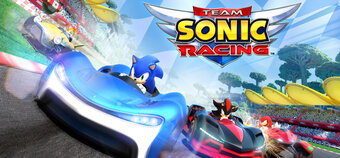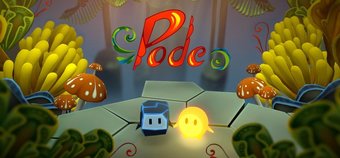It seems that Dr. Robotnik, like most of the world's geniuses, has just been misunderstood. He's not really a fat, egg shaped genius, intent on destroying Sonic, and imprisoning cute animals everywhere inside his evil robots - instead, he just wants to be loved. As a way of repaying the general public, and Sonic, "entirely out of a sense of remorse for his past transgressions", Dr. Robotnik has constructed "Dr. Eggman's Interstellar Amusement Park", a huge intergalactic theme park, where you can take in five planets for the price of one. But of course, you're not to worry, as, as Robotnik himself tells you, it's "in no way associated with any sort of evil plot, or pre-meditated misdeeds." Yeah, right.
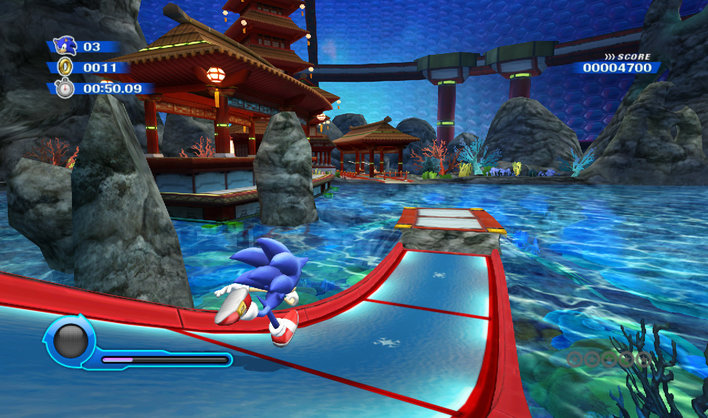
Zooommmm!
But what Sonic Colours actually is, is hard to define. As you speed through the levels, it's constantly changing, both in perspective, and in what it asks you to do. It's both 2D and 3D; side-scrolling, and free roaming; a platforming, score-attack, exploration based adventure through space, with a blue hedgehog wearing bright red shoes leading the way. But while it's hard to define Sonic Colour's gameplay, what isn't hard to decide is that it's also very, very good.
Each of the levels in Sonic consists of racing through a level towards a goal, collecting as many rings as you can, while trying to either avoid, or take out the bad guys, which have been provided by Sonic's nemesis, the nefarious Dr. Robotnik. There's no set format each level takes, and the perspective changes as you move through each level, with the behind-Sonic-camera letting you focus on speed, while the side on camera places more emphasis on precision jumping, and classic Mario/Sonic style platforming exploration.
It may all sound quite complex, but the truth is, it isn't. Although you're running at close to break neck speeds, and, at times, it really feels like it, you're incredibly unlikely to die due to any fault with the game. When there's a bottomless pit beneath you, the game flashes up an exclamation mark to warn you. When you're grinding on a rail, and want to switch to a different one, simply push the analogue stick left and right, and Sonic jumps for you - and lands, perfectly, every time. There's none of the faff that there usually is in the Sonic games, and none of the awkward deaths. While some of the jumps are quite tricky to make, perseverance always pays off.
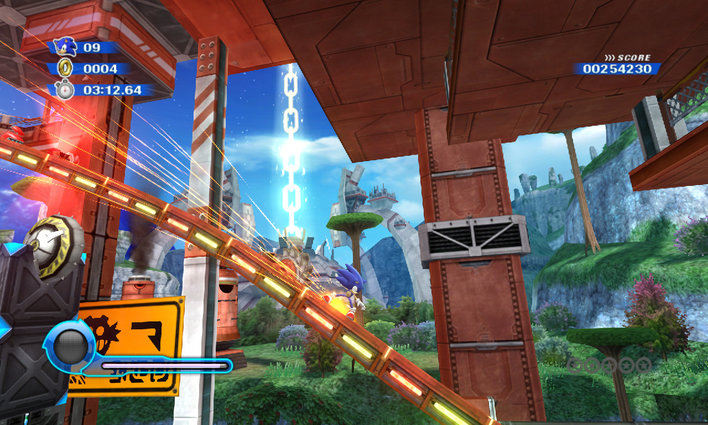
Even grinding down rails is simple.
In fact, possibly the worst part of the game is the wall jumps. This is the biggest faux pas Sonic Colours makes, but, thankfully, it's also one that only affects a very small percentage of the game. In order to do a wall jump (basically climb up a narrow shaft by leaping from one side of a wall to the other), you have to not only press A, but also move the analogue stick from left to right - all in the space of a split second. If they'd allow you just that little bit of extra time to press the button and move the stick, it'd be fine, but instead, all too often you'll find yourself simply sliding to the bottom of the wall. Luckily, there aren't too many times when you'll need the wall jump, but it's still a glaring error, in light of how well everything else has been done.
One of the new features for the latest instalment in the Sonic series is the addition of Wisps. Not only are they a key plot point in the game, which we won't spoil, but these fairly cute little alien type things also add a lot of replayability to the levels, simply because, LEGO style, they aren't all unlocked from the beginning. As you progress through the adventure, and help each type of Wisp out in the storyline, you'll unlock their special powers. Unfortunately, you can't just choose to use your newfound power-ups whenever you want, as instead, you'll have to find them, and break the pods that hold them, which are scattered throughout the levels. Once you've done that, the power-up's stored until you find a good place to use it - or pick up another Wisp, which'll replace it.
Each Wisp is a different colour, which relates to the power it grants you - Yellow wisps let you burrow through soft ground, while Green Wisps turn Sonic into some sort of hedgehog shaped balloon, as he floats to hard to reach areas. By using the Wisps in the right places, you'll be able to find all sorts of hidden areas - and with five red tokens to collect in each level, there's plenty of exploring to do. It'd be a lot easier if you could switch between them at any time, though.
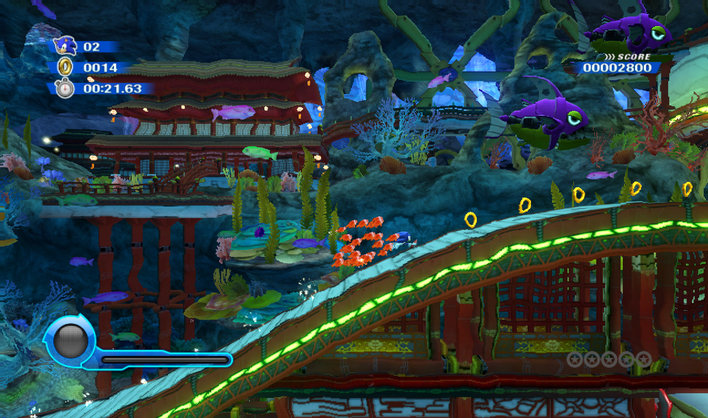
The side scrolling sections are the best.
With six worlds to explore, each containing upwards of five levels, plus a boss fight, there's lots to see and do here, even if you don't take out time to explore. From the outer space thrills of the Starlight Carnival, to the sweet toothed appeal of Sweet Mountain, each world looks completely different, and are often tailored towards a specific type of Wisp. The soft, cakey ground of Sweet Mountain is ripe to be drilled with the yellow Wisp, while the distant platforms of the Starlight Carnival can easily be bridged using the green floaty Wisp. But while the Wisps are mostly easy to use, we did have a few problems with the laser Wisp, which turns Sonic into a laser, as he bounces from crystal to crystal (or enemy to enemy) at the speed of light. Before you fire the laser, you have to set where you want it to go - but for some reason, we kept finding ourselves getting jammed in the targeting mode. It did eventually free itself up, but it was a bit worrying to begin with.
As a game, Sonic Colours has been aimed at all ages, but there's been a specific effort to make it as child friendly as possible. And in fact, one of the best things they've done is to make the game genuinely funny. It's not often a game manages to actually raise not just a smile, but a genuine laugh, yet Sonic Colours does this with a refreshing regularity. The cutscenes that forward the story on, are both entertaining, and funny for kids both big (that's us) and small, and provide a refreshing break from the action.
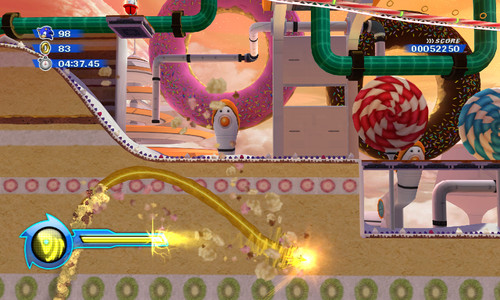
DRILL! The scary voice over man gets into things a bit too much.
Similarly, a lot of effort's gone into making the controls as accessible as possible too. With four control options available, using everything but the Balance Board, Sonic Colours has the option to let you play how you want to. Whether you want to hold the Wii Remote sideways, and play like a classic platformer; add a nunchuck into the mix, and get analogue control; play using a classic controller, or an original Gamecube pad, the choice is yours - and each works as well as the other. The one exception is playing using only the Wii Remote, which doesn't work all that well in the 3D sections, as it lacks 3D control, leaving you bouncing off walls, as you can only run in 8 directions. But even then, it's playable - it's just not as precise as we'd like.
But the Sonic game that just keeps on giving isn't done yet. Along with the huge story mode, they've even shoe-horned a co-operative multiplayer mode in here, which is played in the "Sonic Simulator". Although it's been plastered over the box (as you can also play as your Mii here), the Sonic Simulator really isn't that good - which is a shame, as it shows a lot of potential. What could have been an entertaining co-op side-attraction is turned into a frustration, as, simply by playing the level, you end up repeatedly bouncing on your partner's head - which, more often than not, causes them to fall to their doom. Worse still is that when they respawn, they'll pop back into existence, and, for reasons we can't quite understand, will bounce straight off your head again, causing you to suffer the same fate. It's a frustration that effectively ruins what could have been a very good mode - but thankfully, it's one of few criticisms with this game.
Fast, funny, and full of reasons to keep you coming back, Sonic Colours is a great game for both children and adults alike. With rewarding gameplay, a genuinely funny script, and varied, challenging levels, it's the best Sonic game since Sonic Adventure - and that's not praise we'd throw around lightly.
Format Reviewed: Nintendo Wii











